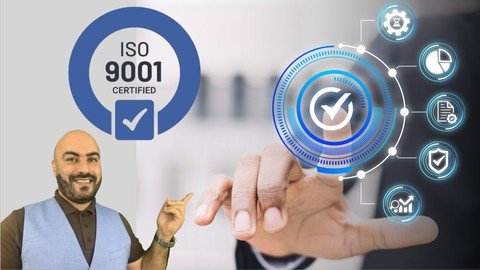
Free Download The Complete Iso 9001:2015 Master Class
Published: 12/2024
MP4 | Video: h264, 1920×1080 | Audio: AAC, 44.1 KHz
Language: English | Size: 4.67 GB | Duration: 3h 39m
Fast-Track Your Quality Journey and achieve Excellence!
What you’ll learn
Explain the importance of ISO 9001 in achieving quality management and improving customer satisfaction.
Understand the structure of ISO 9001:2015 and the seven quality management principles it is based on.
Analyze and interpret the key
Requirements
of the ISO 9001 standard and how they apply to an organization.
Learn how to establish, implement, and maintain a QMS in alignment with ISO 9001
Requirements
.
Use risk-based thinking to identify and address risks and opportunities related to quality management.
Perform a gap analysis to determine what is needed to achieve ISO 9001 certification.
Learn how to create, manage, and maintain the documented information required by ISO 9001.
Acquire skills to plan, conduct, and report on internal audits of the QMS.
Understand the process of obtaining ISO 9001 certification and how to work with certification bodies.
Implement strategies to monitor, measure, and improve the effectiveness of the QMS continuously.
Requirements
Basic Business and Management Knowledge
Description
ISO 9001 is an internationally recognized standard for quality management systems (QMS). It provides a framework for organizations to consistently meet customer and regulatory
Requirements
while striving for continuous improvement. The standard is built around a process-based approach, emphasizing risk-based thinking and customer satisfaction as central pillars. ISO 9001 is applicable to organizations of all sizes and industries, making it a versatile tool for improving operational efficiency, building trust with stakeholders, and enhancing overall performance.The key principles of ISO 9001 include a strong focus on leadership, evidence-based decision-making, engagement of people, and a commitment to continual improvement. It requires organizations to document their processes, monitor performance, and set measurable objectives. By following the Plan-Do-Check-Act (PDCA) cycle, businesses can identify opportunities for improvement, implement changes effectively, and track the impact of those changes over time. This systematic approach helps organizations identify and address risks while optimizing their resources and processes.ISO 9001 certification demonstrates an organization’s commitment to quality and can provide a competitive advantage in the marketplace. Certification is achieved through an external audit conducted by an accredited certification body, which verifies that the organization’s QMS meets the standard’s
Requirements
. Beyond compliance, adopting ISO 9001 can foster a culture of excellence and innovation, enhance customer satisfaction, and drive sustainable business growth. For many companies, it serves as a foundation for building robust quality systems that align with broader strategic goals.
Overview
Section 1: Course Introduction
Lecture 1 Tutor Introduction
Lecture 2 Course Introduction
Lecture 3 Study Plan
Lecture 4 ISO 9001 Introduction
Lecture 5 Purpose of ISO 9001
Lecture 6 Let’s Communicate Together
Section 2: Structure and Clauses of ISO 9001
Lecture 7 Structure of ISO 9001
Lecture 8 Clause 1 – Scope of ISO 9001
Lecture 9 Clause 2 – Normative References
Lecture 10 Clause 3 – Terms and Definitions
Lecture 11 Clause 4 – Context of the Organization
Lecture 12 Clause 5 – Leadership
Lecture 13 Clause 6 – Planning
Lecture 14 Clause 7 – Support
Lecture 15 Clause 8 – Operations
Lecture 16 Clause 9 – performance evaluation
Lecture 17 Clause 10 – Continual Improvement
Section 3: QMS Techniques
Lecture 18 QMS Techniques
Lecture 19 Kaizen Concept
Lecture 20 Six Sigma
Lecture 21 Benchmarking Concept
Lecture 22 Business Process Reengineering
Lecture 23 Delayering Concept
Lecture 24 Management by Objectives
Lecture 25 The 5 Why’s Technique
Section 4: Challenges of Applying ISO 9001
Lecture 26 Implementation Steps for ISO 9001
Lecture 27 Challenges of ISO 9001
Lecture 28 Strategies to Overcome Challenges
Lecture 29 Test and Defect Management
Section 5: Risk Analysis Process
Lecture 30 Risk Assessment & ISO 9001
Lecture 31 What is Risk Identification
Lecture 32 How to Identify Risk
Lecture 33 Hazard and Operability (HAZOP)
Lecture 34 What is Risk Analysis?
Lecture 35 Sources of Information and Risk Analysis Techniques
Lecture 36 Risk Evaluation
Lecture 37 Risk Treatment
Lecture 38 Risk Mapping
Lecture 39 How to Apply and Choose The Risk Treatment?
Lecture 40 Assign Risk Ownership
Section 6: The Certification Process
Lecture 41 The Certification
Requirements
& How to Meet Them?
Lecture 42 Steps to Achieve ISO 9001 Certification
Lecture 43 Certification Audit Process
Lecture 44 Post-Certification Activities
Lecture 45 Benefits of ISO 9001 Certification
Lecture 46 Action Plan
Lecture 47 Course Wrap-Up
Quality Managers,Quality Assurance Specialists,Internal Auditors,Top Management,Operations Managers,Compliance Officers,Supervisors and Team Leaders,Consultants and Advisors,Project Managers,Employees Involved in QMS Processes
Homepage:
https://www.udemy.com/course/the-complete-iso-90012015-master-class/
DOWNLOAD NOW: The Complete Iso 9001:2015 Master Class
Buy Premium From My Links To Get Resumable Support,Max Speed & Support Me
Rapidgator
ylldb.The.Complete.Iso.90012015.Master.Class.part2.rar.html
ylldb.The.Complete.Iso.90012015.Master.Class.part4.rar.html
ylldb.The.Complete.Iso.90012015.Master.Class.part3.rar.html
ylldb.The.Complete.Iso.90012015.Master.Class.part5.rar.html
ylldb.The.Complete.Iso.90012015.Master.Class.part1.rar.html
Fikper
ylldb.The.Complete.Iso.90012015.Master.Class.part2.rar.html
ylldb.The.Complete.Iso.90012015.Master.Class.part1.rar.html
ylldb.The.Complete.Iso.90012015.Master.Class.part3.rar.html
ylldb.The.Complete.Iso.90012015.Master.Class.part4.rar.html
ylldb.The.Complete.Iso.90012015.Master.Class.part5.rar.html